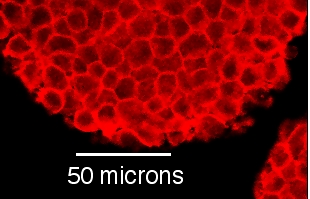Cell Biology/Introduction/Cell size
Appearance
Size of Cells
[edit | edit source]
Although it is generally the case that biological cells are too small to be seen at all without a microscope, there are exceptions as well as considerable range in the sizes of various cell types. Eukaryotic cells are typically 10 times the size of prokaryotic cells (these cell types are discussed in the next Chapter). Plant cells are on average some of the largest cells, probably because in many plant cells the inside is mostly a water filled vacuole.
So, you ask, what are the relative sizes of biological molecules and cells? The following are all approximations:
0.1 nm (nanometer) diameter of a hydrogen atom
0.8 nm Amino Acid
2 nm Diameter of a DNA Alpha helix
4 nm Globular Protein
6 nm microfilaments
7 nm thickness cell membranes
20 nm Ribosome
25 nm Microtubule
30 nm Small virus (Picornaviruses)
30 nm Rhinoviruses
50 nm Nuclear pore
100 nm HIV
120 nm Large virus (Orthomyxoviruses, includes influenza virus)
150-250 nm Very large virus (Rhabdoviruses, Paramyxoviruses)
150-250 nm small bacteria such as Mycoplasma
200 nm Centriole
200 nm (200 to 500 nm) Lysosomes
200 nm (200 to 500 nm) Peroxisomes
800 nm giant virus Mimivirus
1 µm (micrometer)
(1 - 10 µm) the general sizes for Prokaryotes
1 µm Diameter of human nerve cell process
2 µm E.coli - a bacterium
3 µm Mitochondrion
5 µm length of chloroplast
6 µm (3 - 10 micrometers) the Nucleus
9 µm Human red blood cell
10 µm
(10 - 30 µm) Most Eukaryotic animal cells
(10 - 100 µm) Most Eukaryotic plant cells
90 µm small Amoeba
120 µm Human Egg
up to 160 µm Megakaryocyte
up to 500 µm giant bacterium Thiomargarita
up to 800 µm large Amoeba
1 mm (1 millimeter, 1/10th cm)
1 mm Diameter of the squid giant nerve cell
up to 40mm Diameter of giant amoeba Gromia Sphaerica
120 mm Diameter of an ostrich egg (a dinosaur egg was much larger)
3 meters Length of a nerve cell of giraffe's neck
What limits cell sizes?
- Prokaryotes — Limited by efficient metabolism
- Animal cells (eukaryotic) — Limited by surface area to volume ratio
- Plant cells (eukaryotic) — Have large sizes due to large central vacuole, which is responsible for their growth
Related reading
[edit | edit source]- Some early history related to the development of an understanding of the existence and importance of cells. The importance of microscopy.
